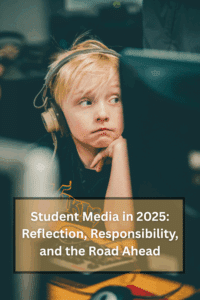Reflection, Responsibility, and the Road Ahead
 As the 2024–25 academic year winds down, student journalists across the country are packing up gear, wrapping final edits, and turning in last stories. For many it’s the end of one of the most intense, unpredictable, and revealing chapters student media has seen in a while.
As the 2024–25 academic year winds down, student journalists across the country are packing up gear, wrapping final edits, and turning in last stories. For many it’s the end of one of the most intense, unpredictable, and revealing chapters student media has seen in a while.
We’ve seen protests broking out on campus, we’ve had to take time to explain complicated institutional changes, and we’re asking hard questions of administrators while finding ways to make content that felt relevant though deep dives in print, 90-second explainers on TikTok, or news summaries on-air.
At a time when universities are increasingly political spaces and the concept of “truth” feels up for debate, student media has proven why it matters. Sometimes this means your work turns into the most consistent, transparent form of accountability a campus has.
What We Got Right—and What We Didn’t
Plenty of student outlets made real impact this year. Some broke major stories, brought attention to underreported communities, or pushed for greater transparency from their schools. Others leaned into new formats including audio, video, and social in ways that brought content to wider, more engaged audiences.
There were missteps, too. Some reporting lacked context. Some headlines went too far. Sometimes we missed the mark entirely. Learning in public is part of student journalism, but that doesn’t make it easier.
Still, those stumbles matter. They’re how we grow. And they’re also a reminder that, increasingly, the line between student and professional journalism is blurred. The stakes can be high, and cramming for finals doesn’t let you off the hook.
Heading Into 2025–26: What’s the Assignment?
Next year’s challenges won’t be easier. If anything, they’ll probably get more complicated. We’re operating in a media climate where lawsuits are being weaponized against legacy media, and where objectivity itself is under scrutiny.
So, what do we do with that?
- We start by being more rigorous. Get the facts right. Don’t rush stories.
- Be curious and critical, not just reactive.
- Talk to more people.
- Ask better questions.
- Own mistakes when they happen, and explain what you’re doing to fix them.
Basically, report more.
Also: don’t fall into the trap of thinking your audience is the enemy. People might come at you hard in the comments or across the table in a student senate meeting, but that doesn’t mean they’re not paying attention. Use that. Invite discussion, not just division.
And tell stories that matter. Some of the most meaningful work doesn’t come from big breaking news, it comes from spending time with people, listening, and documenting the things others ignore. Affordability, identity, policy, and community are the stories that shape campus life and push it forward. Try to find the intersection of where we agree with each other rather than focusing on how we disagree.
The Bigger Picture
This work doesn’t happen in a vacuum. Across the country, legislation is changing what can be taught, said, and published in educational spaces. Faculty and students are under pressure, and so are the publications that represent them.
That means student media isn’t just another club or extracurricular. It’s one of the few places left on campus where truth can be pursued freely, and where power, whether it’s administrative or political, can still be questioned.
That’s a responsibility we shouldn’t take lightly.
So, What’s Next?
As you close your laptops and submit your final files, take a breath. Think about what your newsroom got right this year. Think about what didn’t work. Ask yourself what you’d do differently if you had another shot.
Then come back in the fall ready to do it again but better.
Student journalism doesn’t stop in the summer. It pauses, it resets, and then it picks up right where it left off. We’ll have new questions to ask, new stories to tell, and the same commitment to truth, even when it’s hard.
People are watching. But more importantly, they’re listening.



 As the 2024–25 academic year winds down, student journalists across the country are packing up gear, wrapping final edits, and turning in last stories. For many it’s the end of one of the most intense, unpredictable, and revealing chapters student media has seen in a while.
As the 2024–25 academic year winds down, student journalists across the country are packing up gear, wrapping final edits, and turning in last stories. For many it’s the end of one of the most intense, unpredictable, and revealing chapters student media has seen in a while.